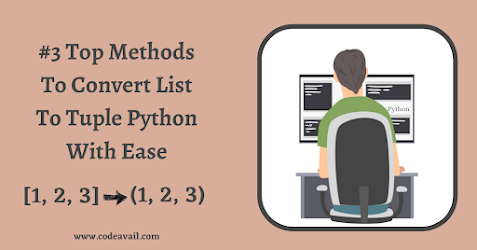Techniques To Convert List To Tuple Python In 2021
Python is ranked first among the top ten programming languages for 2021. And there are a number of programmers who enjoy using this programming language. It's simply not just because it's simple, but it also provides a variety of interesting approaches to work with. Python is an object-oriented language with a variety of data types. And it's self-evident that Python users occasionally need to employ a specific data type to complete a task. The ones that come to mind are list and tuple. However, if you have a list and wish to convert it to a tuple, this is the place to learn about it. Today, I'll go through the top three techniques for converting a list to tuple Python.
Overview of List and Tuple in Python
List In PythonThe sized array in Python is dynamically equivalent to the list. Furthermore, Python lists can contain a variety of components such as texts, numbers, and objects. As a result, the list can be sorted and changed. The element in the list can be declared using square brackets [ ] separated by commas. You can use the index values to access the elements of the list and add and remove elements if needed.
Tuple in PythonIt's a data structure for holding a number of different elements in a single variable. It can also hold a variety of elements (just as the list). It can store a variety of data kinds, and the elements in the tuple cannot be easily added or removed. To define the elements in a tuple, use parenthesis () and commas to divide them.
How to convert the list to tuple Python?
It should be self-evident that a Python coder must perform various operations on the data. And each operation has unique features that change depending on the operations conducted. Python users might need to convert data from one kind to another on occasion. Converting a list to a Python tuple is one of them. So, let's check two distinct approaches. tuple() built-in function We've already discussed that Python offers a variety of data types, with a tuple() being one of them. Here, the iterable is passed as an argument, and it is converted to a tuple object by this function. If you need to convert a list to a tuple in Python, you'll need to supply the entire list of elements as an input to the tuple() method. It will return a tuple data type as a result. Output: ('dog', 1, 2.55)When should you use tuples instead of lists in Python?
It is self-evident that it is dependent on the needs of the individual. If there is no need to update the data, however, the tuple function is handy because it disables the change functionality. However, if the data shrinks or grows during the application's runtime, use the list data type method instead. So, choose one of these (list or tuple) and use it according to your needs and Python program demands.Final words
We hope this has clarified what a list and a tuple are, as well as how to convert a list to a tuple in Python. The methods are applicable on any IDE. Using the methods listed above, convert the list to a tuple if needed. However, keep in mind that the list is mutable, meaning that you can change the entries in the list by adding or removing them. The tuple is not modifiable at the same time. Aside from that, you can ask us for extra information on any Python topics that you find difficult to grasp. I'll assist you in quickly grasping Python ideas. If you still have queries or concerns about Python topics, you can use the Python homework help to obtain guidance and enhance your grades and expertise. Get some more reasons to prefer professionals for Python homework help to obtain programming solutions.Get immediate assistance from Python programmers. The most cost-effective solutions are accessible. Get solutions that are 100 percent accurate. There is also the option of getting immediate assistance. On-time delivery is also an option. There are no issues with refunds or privacy. Request for numerous changes.

No comments:
Post a Comment